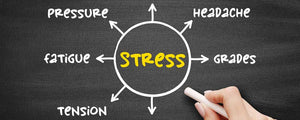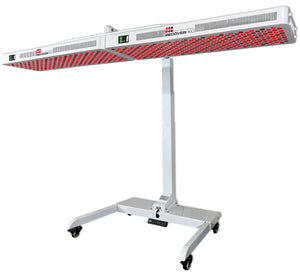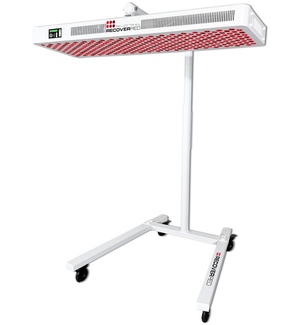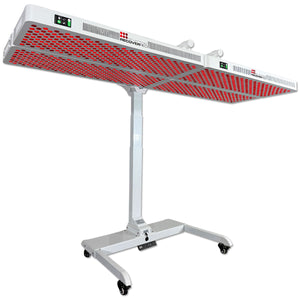However, a slew of recent medical studies now indicates that Red Light Therapy (also known as RLT) may be an effective way of treating anxiety disorders without medication. The same goes for depression. This comprehensive guide aims to educate readers on RLT technology, its effects on depression, stress, and anxiety, and how someone looking for depression therapy or anxiety curing might implement RLT into their wellness routine.
Depression and Anxiety are a Growing Problem

What most people don’t seem to truly understand is that while stress may seem like a “state of being” that can be relieved, depression and anxiety are essentially chronic conditions. For most sufferers, they are no different from Type 1 Diabetes or Cardiovascular disease - there are good days and bad days. So, while you can type “how do I relieve stress” into a search engine and get results, similar searches regarding anxiety and depression will almost always lead to costly therapy or side-effect-heavy medications.
This is precisely why the potential of Red Light Therapy is so noteworthy.
Understanding Red Light Therapy
Red Light Therapy is a form of phototherapy that utilizes red and near-infrared light spectrums to stimulate cellular structure, much like plants absorb light for biological processes. Among its many benefits, it boosts the body's natural energy production, enhances cell regeneration, and reduces inflammation. Perhaps most important of all, RLT is a non-invasive, pain-free treatment option that requires no downtime, making it an increasingly popular method for addressing various health concerns. Thanks to some very good research, we now know that this includes depression and treatment for anxiety and stress.
Indeed, Red Light Therapy represents a groundbreaking approach to anxiety, depression, and stress, utilizing specific light wavelengths (660nm red light and 850nm near-infrared light) to penetrate the skin, muscles, and bones, stimulating cellular repair and regeneration. This process enhances mitochondrial function, improving energy production and overall cellular health. More importantly, RLT's history and evolution demonstrate its growing acceptance and application in medical and therapeutic settings, backed by scientific research supporting its efficacy. Still, it’s only been recently that RLT has emerged as a depression treatment for medication-averse individuals.
Infrared and Near Infrared Light
The journey of RLT from an experimental concept to a recognized therapeutic modality reflects its effectiveness and adaptability. Initially explored to enhance plant growth in extraterrestrial settings, the discovery of RLT's benefits for human health marked a significant turning point. Operating at 660nm (red light) and 850nm (near-infrared light) wavelengths, RLT penetrates different tissue layers, eliciting a range of biological responses. This non-invasive therapy has undergone rigorous clinical evaluation, demonstrating efficacy in treating diverse conditions, from enhancing wound healing to mitigating muscle fatigue, and, increasingly, for the treatment of mental health disorders.
Targeted vs. Full Body Red Light Therapy
Red Light Therapy can be applied in two main ways: targeted and full-body treatments. As the name implies, targeted RLT focuses on specific areas, such as a sore joint or facial skin, using smaller-sized or even portable devices for localized support. In contrast, full-body RLT is designed to offer systemic benefits, such as improved sleep and circulation, by exposing a larger body area to light wavelengths.
Of course, the choice between targeted and full-body treatments depends on individual needs and the specific health issues being addressed. Though targeted light therapy is just as likely to aid in mental health treatment, it’s important to understand that many conditions like this have implications beyond the brain. Since full-body RLT exposes larger body areas to therapeutic light, it offers systemic benefits ideal for conditions affecting the body more broadly. Of course, either approach promotes physiological balance and overall well-being.
Red Light Therapy and Mental Health
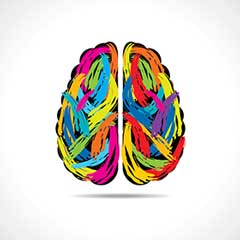
- For example, a lack of natural light can significantly impact one’s mental health, leading to conditions like Seasonal Affective Disorder. RLT offers a way to mitigate these effects by providing the benefits of healthy light exposure, which is essential for cellular function and overall well-being.
- RLT has been shown to relieve stress and improve mood through various mechanisms, including boosting energy levels, harmonizing circadian rhythms, reducing inflammation, and enhancing neurogenesis. These benefits suggest that RLT can be a valuable tool for individuals seeking natural and effective ways to reduce anxiety and cure stress related symptoms.
- RLT presents a unique and attractive treatment option for depression, as it offers rapid symptom improvement without the common side effects of antidepressants. Furthermore, RLT's antidepressant properties and its potential in addressing major depressive disorder and even suicidal ideation have been highlighted in recent studies. This is why many researchers and physicians now feel it has further significance in the field of mental health treatment.
Implementing Red Light Therapy
View Our Most Popular Red Light Therapy Device: The Beam
Incorporating RLT into your daily routine is actually quite easy. The main things to consider are device selection, treatment protocols, and individual needs. That said, it’s crucial that you purchase a device capable of emitting light within the appropriate wavelength range. Moreover, the device's size and energy output need to fit your personal preferences and conditions so that you can optimize your therapeutic outcomes. Finally, tailoring session frequency and duration can significantly enhance RLT's benefits, ensuring a personalized and effective treatment experience.
When shopping for an at-home red light therapy device, make sure to consider the following:
- Mobility – how easy it is to use and move the device can affect how, when, and where you use it.
- Spectrums – Ideally, you want an RLT device with 660nm and infrared 850nm. 850 is the one that can penetrate deeper into the brain.
- Wattage - A RLT device’s wattage refers to the amount of electrical power it uses. Specifically, it indicates how much energy the lamp consumes per unit of time when it is turned on.
- Accessories – This includes the number of light panels, whether or not there is a remote control, eye protection, extension cords, and other things that make using the device much easier.
- Programmability – if using your RLT device on your own, you’ll most likely want to be able to program it for specific treatment cycles.
- Adjustability – If your RLT device is on a stand or rolling mechanism, being able to adjust its height and angle can be a huge benefit.
Conclusion
Medical science is finally recognizing Red Light Therapy as a powerful, non-invasive treatment option with vast potential to address depression and anxiety. Its ability to enhance cellular function, boost mood, and support overall well-being positions RLT as a promising addition to the mental health treatment landscape.As research and clinical practice continue to evolve, the future of RLT’s use in mental health care appears increasingly bright, offering hope and healing to those navigating the challenges of depression, anxiety, and stress.
Research to Link to:
https://www.ncbi.nlm.nih.gov/pmc/articles/PMC2796659/
https://www.ncbi.nlm.nih.gov/pmc/articles/PMC5336550/
https://www.health.harvard.edu/blog/light-therapy-not-just-for-seasonal-depression-202210282840
https://www.sciencedirect.com/science/article/abs/pii/S0165032718311558?via%3Dihub
https://www.ncbi.nlm.nih.gov/pmc/articles/PMC4777909/

